The French 25th Motorized Division was a French Army division active during World War II.
The French 25th Motorized Division was a French Army division active during World War II.
In 1873, 25th Infantry Division was created, which participated in World War I.
In 1935, this division was transformed into the 25th Motorized Division.
During the Battle of France in May 1940 the division contained the following units:
The division was an active division which had existed during peacetime. It was a fully motorized Infantry Division. Led in May 1940 by General Jean-Baptiste Molinié, it was part of the defenders of the Lille Pocket from 26 to 31 May during the Battle of France, after which it surrendered.
Towards the end of the Second World War, the French Forces of the Interior (FFI) from west-central France (notably those of the Charles Martel brigade, Indre-et-Loire, and Loire-Inférieure), were incorporated into the newly formed 25th Infantry Division, deployed in April 1945 in the Saint-Nazaire region. Equipped mainly with capture weapons, it was engaged against the German Saint-Nazaire pocket. [1]

The 66th Infantry Division was a unit of the United States Army during World War II. Activated 15 April 1943, the division trained at Camp Blanding, Florida, and was later transferred to Camp Robinson, Arkansas and then later to Camp Rucker, Alabama before being shipped overseas to England on 26 November 1944. Commanded by Maj. Gen. Herman F. Kramer, the 66th Infantry Division's main role in World War II was containing and eliminating the remaining pockets of German soldiers in Northern France.
The 7th Panzer Division was an armored formation of the German Army in World War II. It participated in the Battle of France, the invasion of the Soviet Union, the occupation of Vichy France, and on the Eastern Front until the end of the war. The 7th Panzer Division is also known by its nickname, Ghost Division.
The French 9th Motorized Division was a French Army division active during World War II.
The French 5th Motorized Division was a French Army division active during World War II.
The 32nd Infantry Division was a French Army formation during World War I and World War II.

The 32nd Infantry Division of the German Army was mobilized on 1 August 1939 for the upcoming invasion of Poland. At that time, it consisted of the usual German infantry division elements: three infantry regiments of three battalions each, one three-battalion regiment of light artillery, one battalion of heavy artillery, a Panzerjäger (anti-tank) Battalion, a reconnaissance (Aufklärungs) Battalion, a Signals Battalion, a Pioneer (Engineer) Battalion, and divisional supply, medical, and administrative units.

The 60th Infantry Division "Sabratha" was an infantry division of the Royal Italian Army during World War II. The Sabratha was raised in May 1937, in Gharyan in Italian Libya and named after the nearby ancient Roman city of Sabratha. The division's regimental depots were in mainland Italy in Campania and shared with the 25th Infantry Division "Bologna", with both divisions recruiting their troops from and training them there. The division was destroyed on 25 July 1942 during the First Battle of El Alamein in Egypt and its remnants used to fill up the depleted ranks of the 102nd Motorized Division "Trento". The Sabratha was classified as an auto-transportable division, meaning it had some motorized transport, but not enough to move the entire division at once.
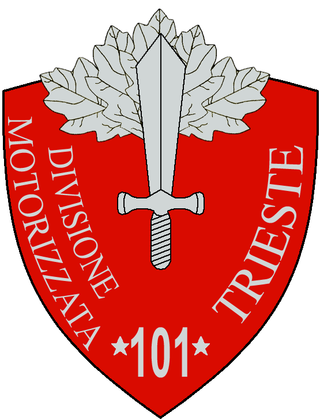
101st Motorized Division "Trieste" was a motorized infantry division of the Royal Italian Army during World War II. The Trieste was formed in 1939 and named for the city of Trieste. The division and its infantry and artillery regiments were based in Piacenza, while the 9th Bersaglieri Regiment was based until 1940 in Treviso and then moved to Cremona to be closer to the division. In September 1941 the Trieste was transferred to Libya for the Western Desert Campaign. The division was decimated in the Second Battle of El Alamein, but was rebuilt with the survivors of destroyed divisions. The Trieste then participated in the Tunisian Campaign until Axis forces in Tunisia surrendered to allied forces on 13 May 1943.

The 25th Infantry Division "Bologna" was an infantry division of the Royal Italian Army during World War II. The Bologna was named after the city of Bologna and classified as an auto-transportable division, meaning it had some motorized transport, but not enough to move the entire division at once.
XLVII Panzer Corps was a panzer corps of the German Army in World War II that was formerly designated as XLVII Corps. Various formations of the corps fought in the French campaign of 1940, in the invasion of Soviet Union from 1941 to 1944, and on the Western Front from June 1944 until April 1945.

The 268th Infantry Division was a German Army division active and operating during the Second World War.
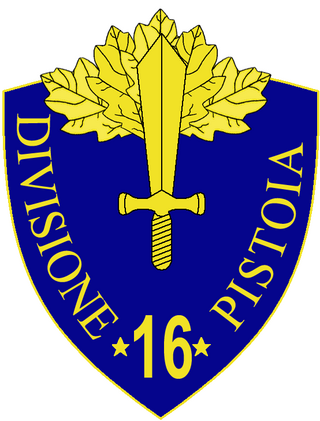
The 16th Infantry Division "Pistoia" was an infantry division of the Royal Italian Army during World War II. The division was named after the city of Pistoia and initially an infantry division, but reorganized to a fully motorized division in 1941. Consequently on 10 October 1941 the division was renamed 16th Motorized Division "Pistoia". The Pistoia had its recruiting area in the central Emilia-Romagna and its headquarters in Bologna. Its two infantry regiments were based in Bologna (35th) and Modena (36th), with the division's artillery regiment based in Bologna.
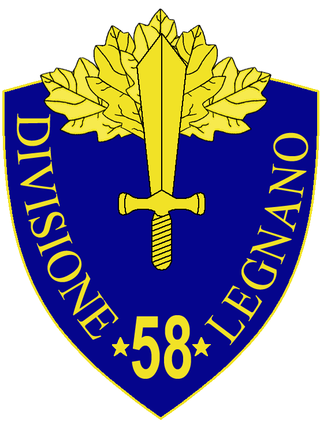
The 58th Infantry Division "Legnano" was an infantry division of the Royal Italian Army during World War II. The Legnano's predecessor division was formed on 8 February 1934 in Milan and named for the medieval Battle of Legnano. On 24 May 1939 the division split to form the 6th Infantry Division "Cuneo" and the 58th Infantry Division "Legnano". After the announcement of the Armistice of Cassibile the Legnano resisted the invading German forces. The division's staff and 67th Infantry Regiment "Legnano" were used to form the first unit of the Italian Co-belligerent Army, which fought on the allied side in the Italian campaign. On 17 February 1944 the division's last units joined other commands and the division was officially dissolved.
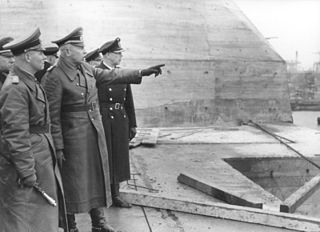
Wilhelm Fahrmbacher was a general in the Wehrmacht of Nazi Germany during World War II who commanded several corps, including VII Corps, XXV Corps and LXXXIV Corps, fighting on both the Eastern Front and Western Front.

The 126th Infantry Division was a German division in World War II. It was formed on 18 October 1940 in Sennelager.
The 254th Infantry Division was an infantry division of the German Heer during World War II.
The 266th Infantry Division was an infantry division of the German Heer during World War II.
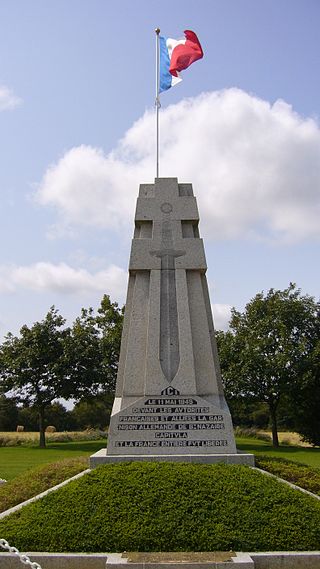
The Saint-Nazaire Pocket was an Atlantic pocket that existed from August 1944 until 11 May 1945 and was formed by the withdrawal of German troops from Loire-Inférieure during the liberation of the department by the allied forces. It was centred around the port and the submarine base of Saint-Nazaire and extended to the east as far as Saint-Omer-de-Blain and from La Roche-Bernard in the north to Pornic in the south.
Raymond Emmanuel Marie Siméon Chomel was a French General and leader of the resistance during World War Two.